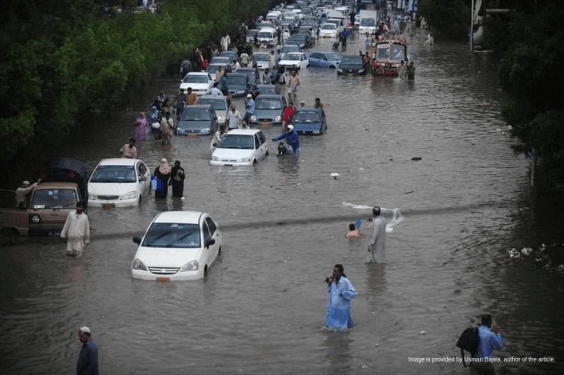Climate Resilient Cities for Sustainable Pakistan

By Usman Bajwa

Climate_Resilient_Cities_for_Sustainable_Pakistan
Twenty first century belongs to cities as the global landscape has been urbanizing rapidly. According to UN Habitat, presently 55 percent of the global population is residing in urban settlements and it is projected to be 68 percent in 2050. The unprecedented pace of urbanization coupled with unplanned development has turned cites into concrete jungle. Cities are encroaching on prime agricultural land and green zones of this planet. Unplanned urbanization
has brought other environmental problems including deforestation, water scarcity, urban flash flooding, heat waves and smog. UN Habitat report “Hot Cities: battle-ground for climate change” highlighted that urban settlements are contributing 70 to 80 percent to greenhouse gas emissions and wreaking havoc on global ecology. As a result, the ecological crises have led to climate change on this planet.
United Nations Framework Convention on Climate Change elucidated that the anomaly of climate change primarily evolved due to human interventions such as burning fossil fuels and industrialization. Over the decades, these man made activities are altering the global climatic patterns. The adverse impacts of climate change are striking all over the globe; particularly Asia and Africa are more vulnerable to the natural calamities. Increasing in global temperature has
added to the severity of extreme weather events and has led to displacement of large populations. In particular, climate change has alternated the global water system.
In last two decades, Pakistan has become a hotbed for climatic trepidations due to myopic governance along with futile city and regional planning policies. Statistics of Global Climate Index 2018 has listed Pakistan among top 10 countries, which are most vulnerable to climatic maledictions and extreme natural disasters.
The recurring tendency of natural disasters in Pakistan is putting stress on urban economy and life, by affecting livelihoods of people. In 2010 floods, the economic losses are estimated to be around $10 billion besides loss of precious lives. This year once again monsoon rains have wrecked metropolitan cities of Pakistan by urban flooding. Particularly, Karachi City which is considered as an economic backbone of the country is presently facing the curse of torrential rains. The death toll reached to 27 and many urban residents got injured due to flood incidents. The substandard electricity distribution added to the death toll of humans and sacrificial animals alike. The pivotal concern for city planners is to critically analyze the whole picture of the city after the flood. Poor governance and lack of sanitation and garbage disposal mechanisms in the city have enhanced the climate change vulnerabilities for the citizens of Karachi. Indeed, the water management and drainage system of any city in Pakistan has not evolved with changes in population that negatively affects the climate resilience of cities.
The grave situation of climatic changes triggered the idea of climate resilient cities at international forums and incited urban planners to realize cities planning and designing through climate resilience lens. Land use and building control practices are important tool for the adaptation of climatic changes. Building and land use bylaws can ensure the elements of sustainability such as enforce rainwater-harvesting practices at individual household level, urban farming, and multimodal public transport planning which discourage the usage of cars.
Further, rainwater harvesting has gained prominence globally. Rainwater harvesting is a systematic process of rainwater collection from the rooftops of the buildings and surface run off by pipes and storage tanks installed in buildings. The water preserved from rainwater harvesting process has potential to be used for the domestic, commercial and agricultural purposes except drinking. In first phase all public buildings, and other public places may be adapted to the rainwater harvesting system followed by extending implementation to housing units.
The present government has launched clean and green Pakistan drive, which is a good step towards building climate resilience. However, there is an urgent need to develop a holistic policy framework. The town planning practitioners and urban planners may guide local development agencies and communities for the adaptation of environment friendly spatial and infrastructure planning. Climate change phenomenon is a ticking bomb that has can potentially have grave
implications for the quality of life of people and survival for a large part of population in not so distant future.
About Author
Usman Bajwa is an MPhil scholar of City and Regional Planning at University of Engineering and Technology, Lahore. Presently, he is serving in Urban Unit as an Urban Planner in Urban Development Sector.




1 Comment
Well, it’s a good piece of writing covers most of the aspects that are causing severe repercussion to not only our environment but health as well. Urban planning at this juncture is the need of the hour in order to tackle climate change which in turn affects economy as well. However, rainwater collection is an easy step to be opted but awareness is required in this regard. You might quite various examples of Pakistan and lesson learns.